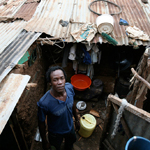
Principles of Sustainability
Chapter 4 - The Built Environment
Part 4 - The Urbanization of Poverty and Slums: Challenges for Sustainability
 Cities are focal centers for sustainability. The world's future is an urban future. The majority of global future population growth will occur in urban areas, and the infrastructure to support this growth in many developing areas is limited. This can result in the acceleration of unstable housing developments called slums, shanty-towns, squatter communities, and illegal or informal settlements. These areas are manifestations of urban poverty, and they are common in many rapidly growing urban centers around the globe. These areas typically lack basic services such as water and sanitation leading to poor health, disease, and higher rates of mortality and morbidity. The informal economies and lack of community services such as education and health care contribute to a chronically challenging life for those living in these high-density living areas.
Cities are focal centers for sustainability. The world's future is an urban future. The majority of global future population growth will occur in urban areas, and the infrastructure to support this growth in many developing areas is limited. This can result in the acceleration of unstable housing developments called slums, shanty-towns, squatter communities, and illegal or informal settlements. These areas are manifestations of urban poverty, and they are common in many rapidly growing urban centers around the globe. These areas typically lack basic services such as water and sanitation leading to poor health, disease, and higher rates of mortality and morbidity. The informal economies and lack of community services such as education and health care contribute to a chronically challenging life for those living in these high-density living areas.
Slum upgrading is a successful urban renewal approach to help in the provision of basic services and a pathway to stable housing and land tenure. Present and future urban planning will need to address the reality of rural to urban migration with sustainable, cost effective approaches to accommodating the population growth experienced by urban centers.
Keywords
- Urbanization
- Sustainable urbanization
- Urban poverty
- Slums
- Sustainable development
- Resilience
- Urban planning
- Rural to urban migration
Suggested Reading
-
UN Habitat - World Cities Report 2020 - The Value of Sustainable Urbanization - Key Findings and Messages, pp xv-xxxvii
- UN Habitat - World Cities Report 2020 - The Value of Sustainable Urbanization - Chapter 1: Urbanization and Cities, Trends of a New Global Force, pp 1-42
(Photo credit: UN Photo)
